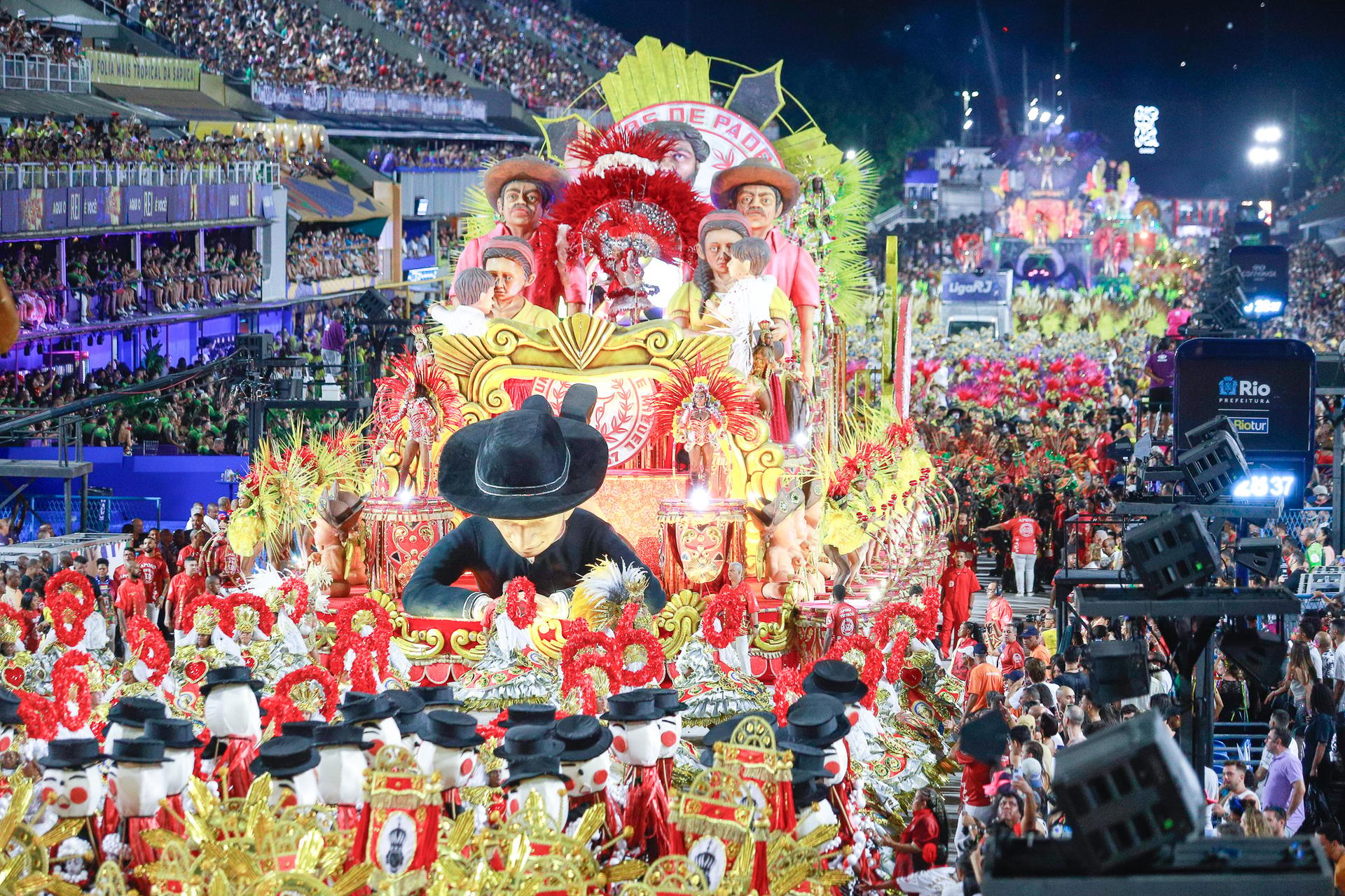SÃO PAULO – The 2024 Carnival’s champion of the second most important league of samba schools in Rio de Janeiro, Unidos de Padre Miguel, paid tribute to Father Cícero Romão Batista, the greatest of all folk saints in Brazil.
While the parade’s theme was able to move many participants and spectators, not everybody liked the idea of seeing “Padim Ciço” – a diminutive form of Padre Cícero, as he is affectionately called by many of his devotees – being portrayed by Carnival organizers.
UPM’s presentation was named The redeemer of the sertão, as the dry backlands of the Northeastern part of Brazil are known, and told the story of Batista and of the popular devotion to him, especially in that region.
One of the floats had a giant sculpture representing Padim Ciço. The different sections of the parade referred to distinct parts of his life, as well as important aspects of the devotion people have for him. Some of the costumes worn by UPM members exhibited paintings of Our Lady, while others alluded to elements of Northeastern culture.
Footage of the parade showed many people carrying sculptures of him across the entire event.
Padim Ciço lived from 1844-1934. In 1872, he established himself in Juazeiro do Norte, which was at that time an abandoned district of the city of Crato, in Ceará state. Over the years, he developed the region’s agriculture by applying new methods and bringing more productive strains of sugarcane and cassava from nearby states.
The Northeastern part of Brazil has been historically plagued with severe droughts which would expel thousands of small growers every year. The land was concentrated in the hands of a few farmers. Great masses of peasants would look for better living conditions elsewhere – and soon many learned about Padim Ciço’s work in Juazeiro.
The priest would welcome every new family that arrived there and give them work and a place to live. In a few years, Juazeiro do Norte would see enormous growth, and Padim Ciço became famous as a holy priest who helped the poor.
In 1889, a very pious woman of his community named Maria de Araújo said that the wafer she received from Padim Ciço during Communion turned into blood in her mouth. She kept the handkerchief with the mysterious blood stains as proof of the phenomenon, which she said happened 46 times.
After that, Padim Ciço’s notoriety as a holy man grew even more and people from different regions would move to Juazeiro do Norte. Rich people donated estate and money to him, and he became a powerful man with local political prominence – but always used his resources to help the poor.
According to experts in his biography like professor Renato Casimiro, the Church never knew how to deal with Padim Ciço. The local diocese ended up suspending his orders for a period, and the Vatican even issued an excommunication order against him, which was never carried out.
After his death in 1934, the Church tried for decades to restrict his fame among the people from sertão, but was never able to do so and numerous pilgrims would visit Juazeiro do Norte every year. As great masses from the Northeast migrated to other regions, including Southeastern cities like Rio de Janeiro and São Paulo, devotion to Padim Ciço became national.
Over the past decades, Padim Ciço has been gradually rehabilitated by the clergy, and the process of his beatification was finally opened in 2022. Nowadays, around two million pilgrims go to Juazeiro do Norte every year.
It’s not surprising that a samba school chose Padim Ciço as the theme of its annual Carnival parade.
Most samba schools in Rio de Janeiro are located in favelas, where many migrants from the Northeast and their descendants live. Padim Ciço is part of the imagination of many people involved in the Carnival world in Rio.
Many devotees were happy about the homage and celebrated the fact that Unidos de Padre Miguel was the winner of the 2024 Carnival Golden Series – the second most important league in Rio – and in 2025 will parade among the major samba schools in the city. Some of them even attributed the victory to Padim Ciço’s intervention.
But other devotees recalled that Padim Ciço was a conservative man and didn’t like the fact that Carnival organizers used his history in a “profane” festivity. Comments attacking such an “inadequate combination” could be seen on social media pages dedicated to him.
Renato Casimiro, who had family members who were friends with Padim Ciço and knew him very well, was among the people who rejected Unidos de Padre Miguel’s parade.
“In 1925, Congressman Floro Bartolomeu da Costa organized the first public Carnival festivity of Juazeiro do Norte. Padre Cícero criticized it in private talks with friends, some of them members of my family,” Casimiro told Crux.
He said the 1925 celebration “obviously didn’t include all that debauchery that is seen in samba schools’ parades nowadays,” and even so, Padim Ciço repudiated it.
“It’s not a puritanical critique. We just think that it’s something that doesn’t fit with the extraordinary figure of Padre Cícero and his effort to build a society whose ethical and moral standards corresponded to its faith identity,” Casimiro said.
He believes that Padim Ciço’s image was “exploited by people involved with the samba school, people who have already used Padim Ciço to their own interests in the past in order to make a living from him.”
Father Luiz Antônio Pereira Lopes, who heads Rio’s Favelas Pastoral Ministry, knows the Padre Miguel neighborhood, where the samba school is located, very well.
“It received the name of Father Miguel Mochon (1879-1947), who was the vicar of an immense territory that today corresponds to a number of neighborhoods. My father and my uncles were baptized by him,” he told Crux.
The missionary’s history, a man who built churches and schools in that region, was told by Unidos de Padre Miguel in a parade years ago, Pereira Lopes recalled.
“That’s a region with plenty of people from the Northeast. That’s why they chose Padim Ciço. It was an important homage,” he added.
Pereira Lopes admitted that for Brazilians who don’t live in Rio, “the images of the Carnival that appear on TV give the impression that there are several women dancing half-naked, but that’s only a smaller part of the participants.”
“It can appear as a profanation, but everything is carried out with respect nowadays. Some carnavalescos [the artists in charge of the whole parade] even consult the Church in order to avoid anything scandalous when they’re dealing with religious topics,” Pereira Lopes said.
Times have changed. In 1989, the most famous carnavalesco in Rio, Joãosinho Trinta (1933-2011), in charge of the parade of the samba school Beija-Flor de Nilópolis, included a float carrying a Christ the Redeemer dressed as a beggar.
The Archdiocese of Rio de Janeiro sued the samba school and obtained an injunction prohibiting it to show the Christ float during the parade. Joãosinho Trinta covered the sculpture with trash bags and a giant banner that said: “Even forbidden, watch over us.”
“I was part of the Church committee that tried to negotiate with the carnavalescos. But they had an arrogant attitude and told us we didn’t have a say in their parade. Those were different times,” Pereira Lopes said, adding that today there’s an open dialogue between the Church and the samba schools.
Nudity was more common in those years. In 1988, a woman paraded completely naked. Rio’s Carnival league prohibited in 1990 the exposure of genitalia during presentations, and since then paraders wear at least a loincloth.
But the samba schools are gigantic – each one in Rio parades with at least 2,500 people – and most of their participants are regular people who just want to wear a costume, play an instrument and dance. Invited artists and models – the ones who usually show half-naked bodies during the parade – are a small minority.
“I know some people who took part in the Unidos de Padre Miguel parade. They even sent me pictures of their costumes and asked me if there was any problem with them,” Pereira Lopes said.
In his opinion, the pictures of the parade show that there was nothing scandalous about it.
“Carnival is joy and joy is something Christian. For those people, Padim Ciço is already a saint. It was something beautiful,” he said.















